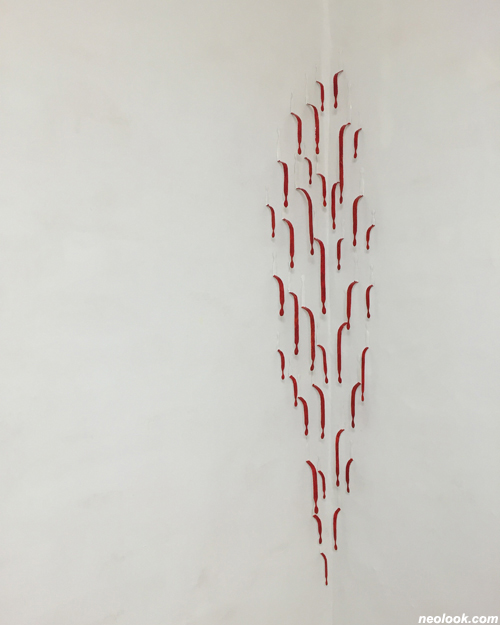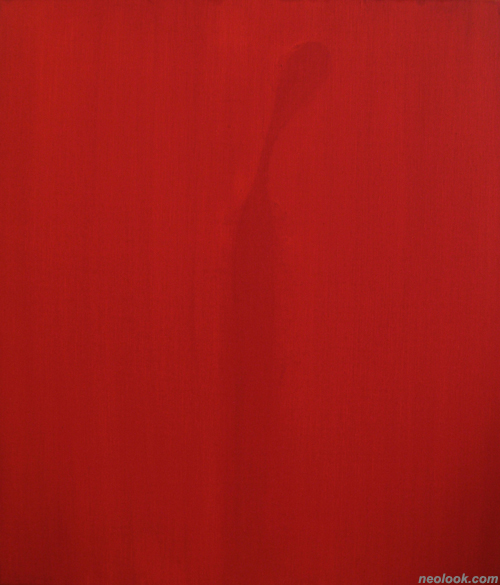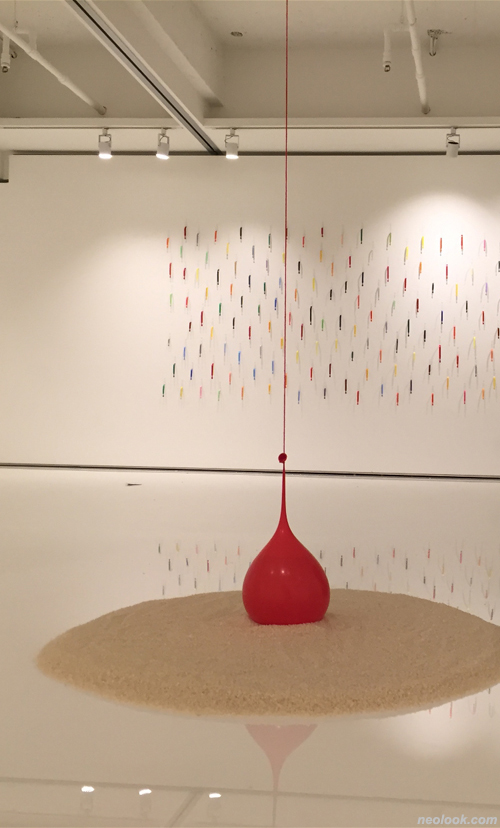- ● homepage
- ● archives
- ● restoration
- ● books
- ● big banners
- ● post board
- ■ neo's search
- ■ about us
- ■ 게재방법 안내
- 개인정보처리방침

- [email protected]
- Tel. 02_335_7922
- Fax. 02_335_7929
- 10:00am~04:30pm
- 월요일~금요일
- 3/3(월) 대체공휴일

사유의 틀 mold of sayu 思维的框
고강필展 / KOGANGPIL / 高康弼 / painting.installation 2015_1216 ▶ 2015_1223
● 위 이미지를 클릭하면 네오룩 아카이브 Vol.20140321a | 고강필展으로 갑니다.
고강필 블로그_blog.naver.com/kogangpil 인스타그램_@kogangpil
별도의 초대일시가 없습니다.
관람시간 / 10:00am~07:00pm / 주말_10:00am~06:00pm
레스빠스71 L'ESPACE71 서울 강남구 압구정로71길 5 (청담동 141-11번지) 중인빌딩 B1 Tel. +82.(0)2.511.7101 www.lespace71.com
모더니즘의 회귀 ● 고강필 작가의 2014년의 회화작품은 전체적으로 화려한 채색 속에 인체가 덩그러니 놓여져 있다. 인체는 팔과 다리도 없이 한쪽으로 기울어진 고개와 함께 서 있는 모습이 둘이 아니라 더 외롭다. 화려한 색으로 자칫 놓칠 수 있는 인체의 형상은 불안하기보다 처연해 보이기까지 하다. 작가의 전시 타이틀처럼 사유의 무게에 눌린 인간, 그리고 홀로 힘겹게 버텨내야 하는 현대인, 그 안에 속해있는 작가의 자화상이 아닌가 싶다. 그림은 작가의 반영이요. 작가의 주관, 생각 그 자체일 것이다. 몇몇 작가는 그래픽 기술과 더불어 세련되게 자신을 표현하기도 하고, 다양한 재료로 과대하게 포장하기도 하지만, 고강필작가는 작품이 '그'다. 그리고 작가는 자신의 작품에 '사유의 틀'이라 명명한다. 사람은 누구나 자기 자신만의 고유한 사고의 틀을 가지고 있고, 제각각 그 틀에 걸맞는 언어를 사용하고 있다. 그림을 그리는 작가에게 있어 그 틀은 그를 타인과 구별짓는 고유의 방식일 것이다.

- 고강필_사유의 틀展_레스빠스71_2015
칸트는 인간의 가장 고차원적인 심적 능력으로 '사유'를 들고 있다. 일반적 감성의 작용과 구별하기 위해 '사유'의 개념을 판단, 추론 등의 작용으로 설명한다. 또한, 개별적인 것으로 향하는 감각에 반해 사유는 보편적인 것, 본질의 파악에 관한 능력으로 본다. '생각하다'라는 의미를 담고 있는 '사유'는 인간이 주체인 이상 감성과 떼어 생각할 수 없다. 감성과 사유의 관계는 서로 상호 의존적이며, 그래서 칸트는 인식이란 '감성' 없이는 어떠한 대상도 주어질 수 없다고 하였다. 그러한 인간을 감정의 동물이라 하지 않던가.

- 고강필_mold of sayu ik 2014-1_나무에 아크릴채색, 스테인리스_91×117cm_2014

- 고강필_mold of sayu ik 2015-3_나무에 아크릴채색, 스테인리스_105×76cm_2015
작가 고강필은 '사유'의 대상으로 사유의 주체인 '인체'를 선택했으며, 그 인체는 작가 자신일 수도, 작가가 바라 본 세상속 대중의 표본일 수도 있다. 그 인체는 갸우뚱한 머리로 세상을 이해하기 어려워하는 모습을 떠올리게 하며 혹은, 홀로 서서 세상과 맞싸우는 고독한 존재로도 떠올리게 한다. 양자 모두 힘든 세상에 실의에 찬 주체다. 자코메티의 조각작품처럼 인체를 가늘고 길게 표현하여 고독한 느낌을 주는 그의 작품은 고뇌에 찬 실존주의적, 비관주의가 느껴진다. ● 그렇다면 고강필작가에게 '인간'이란 무엇을 의미하는가? 일부 작가들은 진정한 자아를 찾기 위해, 혹은 자유로운 존재로서의 자신을 표현하기 위해 인체 작업을 한다. 융심리학과 실존주의 철학에 영향을 받은 이들은 '자기 인식', '자의식', '사유'처럼 자신 내면, 자아의 중요성을 강조하기 위해 표현한 것이다. 그러나, 고강필작가의 작품 속 인체는 어디에도 속하지 않는다. 칸트가 사유에 대한 개념을 정의하고자 부여한 '본질파악'에 관한 능력에 충실하고자 한 의도가 엿보인다. 그렇다면 그에게 본질이란 무엇일까? 실로 인체의 형상 속에서 작가는 어떤 본질을 찾고자 인체의 실루엣을 따라 여러번 그어 내려갔으며, 그러한 붓질 행위로 작가가 찾고자 했던 본질은 무엇일까? 캔버스 위에 수십 번의 붓질을 통해, 쌓이는 안료층에 의해 작가는 자신만의 세상을 쌓아갔을 것이다. 화려한 색 뒤에 숨은 작가의 고뇌와 작업에 대한 정성은 작가에게 치유요, 세상과 대응해가는 고강필작가만의 방식이었을 것이다. 현대인이 거대한 빌딩 숲과 화려한 조명 뒤로 살아남기 위해 고군분투해야 하는 삶을 대변하 듯 말이다.

- 고강필_mold of sayu ik 2014-3_나무에 아크릴채색, 스테인리스_가변크기_2014
서구 전통에서 오랜 역사를 지닌 장르인 초상화와 자화상은 오늘날 미술의 정체성에 대한 탐색과 직결되기도 하지만, 작가가 세상을 바라보는 창이기도 하다. 고강필작가의 이전 작업 또한 초상화, 자화상의 연작이 많았으며, 이는 곧 인간에 대한 관심, 갈망을 의미하며, 자신에 대한 깊은 성찰을 기반한다. 이때 그의 인체표현의 선들은 현대인의 먹거리 1위로 꼽히는 라면처럼 구불거리는 선들로 드로잉의 연장선인양 자유롭다. 구부러진 하나 하나의 선이 얽히고 섥혀, 형태와 형상을 이루어 생동감 있는 인물을 형성한다. 그 인물들은 일상 속, 우리의 모습들이며, 서민의 먹거리인 라면과도 상통한다. 구체적이고 열거식이었던 작업들이 작가의 작업과정이 진행 될수록 정리되듯 단순화된다. 이에 반해 작가는 더 많은 심오함, 이상과 현실의 괴리, 인간으로서의 불안, 미래에 대한 두려움 등 현재의 수많은 자기 감정을 억제해 누르고 반복된 붓질 속에 담고 있다. 현대미술이 벗어나고자한 모더니즘을 고강필작가는 신표현주의처럼 깨려고 하지 않고, 신추상주의처럼 다시 되돌리지도 않으며, 그렇다고 현재의 동시대 미술에 편승하지도 않는다. 심각하고 엄격한 작가의 내면은 읽기 어려운 모더니즘의 회귀를 꿈꾼 듯 하다.

- 고강필_mold of sayu ik 2015-5_나무에 아크릴채색, 스테인리스_53×41cm_2014~5
서구의 경우 20세기에 들어서 비구상미술을 실험하기 전까지 절대 다수는 구상의 형태를 띠고 있다. 사진 역시 발명 당시부터 인간을 주요 모티프로 삼았다. 구상은 작가들에게 형식과 내용을 모두 제공해 왔기에 신체 자체보다는 신체에 따른 역사나 개인적인 심리반영, 사회에 대한 이야기, 자신이 처한 상황 같은 것에 주목하기에 인간형상은 가장 오래되고도 중요한 미술 모티프 중 하나다. ● 그의 인체 소재는 변화를 시도한다. 평면에서 입체로, 하나에서 군중으로, 사각 틀에서 가변 설치로, 그의 시도는 자유롭게 확장해 나가고 있다. 자신의 엄격한 내면의 세계를 깨고 밖으로 뛰쳐 나가 듯 그의 작업은 변화를 시도하며 다양한 재료와 방법을 추구한다. ● 실존, 불안, 걱정. 현대인이라면 누구나 갖고 있고, 짊어져야 할 무게다. 작가는 그것을 작업으로 승화해 가고 있는 것이다. 작품에서 선, 형상이 작가의 이성적 반영이라면, 색은 감성의 반영에 더 가깝다. 작가의 이성은 심오하고 억제되어 있지만, 이와 대조적으로 색은 열정으로 가득하다. 근래 시도 중인 설치작품의 다변화된 작품처럼 쉼없이 활동하여 작업영역을 펼쳐 나간다면 작가 자신도 언젠가는 자신의 작업으로 던진 물음들에 대한 대답을 스스로 찾지 않을까 한다. 고강필작가에게 끝도 답도 알수 없는 무모한 도전일 수 있는 작업은 지금도 진행 중이다. ■ 임경미

- 고강필_mold of sayu ik 2015-6_나무에 아크릴채색, 스테인리스_53×45cm_2014~5
삶의 중력에 의해 아래로 꺾어 내려가는 사유의 틀은 감각적 사유를 통해 공간에 떠다니는 수 많은 존재와의 충돌로 인해 물들어지고 빛에 의해 사유의 틀은 그림자가 나타난다. ■ 고강필

- 고강필_sayu2014-12_캔버스에 아크릴채색_53×45cm_2014
Return of Modernism ● In the artist Ko gang-pil's painting, there stood a human body alone in the colorful background overall. The body tilting the head to one side without arms and legs stands by oneself so it looks lonelier. The human figure that can be easily missed due to showy color even looks sorrowful rather than fearful. Like his exhibition title, it seems to symbolize humans under the weight of thought, contemporary people who have to struggle alone, and the artist's portrait that belongs here. Painting may be the artist's reflection, subjective idea, and thought itself. Some artists express themselves very sophisticatedly with graphics technology, and exaggerate with various materials. But, the artist Ko gang-pil's work is all about 'himself'. And, the artist names his work 'Framework of Thought(Sayu)'. Anyone has one's own framework of thinking and uses proper language for it. To this painting artist, the framework can be his own way to distinguish him from others. ● Kant points 'thought' as man's highest psychological ability. He explains that the concept of 'thought' is an activity of deciding and reasoning to distinguish from general emotional activities. Also, thought is regarded as something universal and an ability to identify nature compared to emotion aiming at individuals. We cannot isolate 'Thought(Sayu)', which means thinking, from emotion so long as man is the subject. The relationship between emotion and thought is interdependent, so Kant said "No perception can be given without 'emotion'" as there is a saying man is a creature of impulse. ● The artist Ko, gang-pil chose 'a human body' which is the subject of thought as the target of 'thought', and the human body can be the artist himself or model of the public in society. The human body tilting his/her head to one side seems to have difficulty understanding the world, or looks like a lonely being facing the world alone. Both are the subjects despondent about the tough world. Like Alberto Giacometti's sculpture, a human body is very thin and long in his work that gives a feeling of loneliness and even an anguished feeling of existential and pessimistic views. ● Then, to the artist Ko gang-pil, what does 'man' mean by? Some artists draw a human body to find their true self or express oneself as a free being. Those affected by Jungian psychology and existentialism express it to emphasize their inner side and the importance of self like 'self-awareness', 'identity', and 'thought'. However, a human body in the artist Ko gang-pil's work doesn't belong anywhere. His work shows the artist intention to focus on the ability of 'identifying nature' given by Kant to define the concept of thought. Then, what is nature to him? Indeed, he lines a silhouette of the human body many times to find a true nature from the shape of human body, and what is the nature he is seeking through such painting? The artist might build his own world through layered pigments by painting with a brush on the canvas dozens of times. His hidden agony and devotion to his work behind showy color may be healing to him and his own way of facing the world. It is like contemporary people struggle for a living behind a forest of high-rises and colorful lighting. ● Portraits and self-portraits with a long history of western art are directly related to exploration of art identity, but it is also a window for him looking at the world. Ko, gang-pil's previous works were also mostly a series of portraits and self-portraits, and this means interest in and longing for man and is based on deep self-examination. In his work, the lines of expressing a human body are curvy like noodles(ramen), the number one food for contemporary people and free like extension lines of drawing. Each of the curvy lines is intertwined and intermingled, thereby making a shape and a form to create lively figures. The figures are our images of everyday life and are parallel to noodles(ramen), ordinary food. His works that used to be detailed and listed are being simplified, seeming to be organized as his work process goes along. On the contrary, the artist is repeatedly painting with a brush while suppressing his numerous emotions such as more profundity, disparity between ideals and reality, human fear, and anxiety about the future. The artist Ko, gang-pil neither attempts to break from modernism, which modern art desires to go beyond, like neo-expressionist, returns like non-abstractionism, nor jumps on contemporary art in the modern world. His serious and strict inner side appears to dream of the return of modernism difficult to read. ● In Western art, a majority of works were forming a figure until Art Non-Figuratif was experimented in the 20th century. Photos have also used man as main motifs since its invention. A figure has provided both shape and content to artists, so a human shape is one of the oldest and most important art motifs because not a human body itself but history of a human body, reflection of personal emotions, stories about society, and one's own situation are focused. ● A human body in his work tries a change. From 2D to 3D, individuals to the public, and square frame to variable installation, his attempt is expanding freely. His work tries changes and pursues various materials and methods like he breaks from his strict inner world to go out. ● Existence, anxiety, worry. Those are the weight every contemporary man has and shoulder. The artist is sublimating it in art work. In his work, line and shape are the reflection of the artist's rationality while color is more like the reflection of his emotion. His rationality is profound and repressed whereas color is full of passion. Like varied installation work he is trying recently, if he continues work activities, he would find the answers to the questions he poses through his work. The artist Ko, gang-pil is still working on work that may be a foolhardy challenge with no end and answer. ■ Lim Kyung-mi
Framework of thought bent downwards by the weight of life is dyed as it collides with numerous beings floating in space through emotional thought, and casts a shadow caused by the blocking of a light source. ■ KOGANGPIL

- 고강필_풍요속의 사유의 무게_쌀 20kg, 고무풍선, 물, 털실_가변설치_2015
现代主义的回归 ● 从高康弼作家的2014年绘画作品来看, 在华丽色彩里只有一个人体, 而且没有四肢, 倾斜的头部。这不是两个人, 所以让人觉得很孤独。在华丽色彩中会没看见人体形象, 这看起来让人感到不安, 甚至凄怆。像作家的展览会题目那样, 思维负担而被抑制的额人间, 只在自己一个人要坚持的现代人, 这是属于其里面的作家自画像。画是作家的反映、作家主观、想法其本身。有些作家与图形技术在一起精炼地表现自己, 以多样材料过分包装, 而高弼康作家作品就是"他"本身。作家将自己的作品命名为"思维的框架"。任何人都有自己固有的思维框架, 使用符合于其框架的语言。对画画的作家来说, 其框架就是与他人有区别的固有方式。 ● 康德对人的最高层次心里能力提出"思维"。一般来说, 为了区别于感性的作用, 对"思维"概念解释为判断、推断等作用。而且与个别感觉相比, 思维是普遍的, 掌握本质的能力。"思维" 意为"想", 作为主体人离不开感性。感性和思维是互相依赖关系, 正因如此, 康德主张认识离不开"感性"。所以人被称为感情的动物! ● 高康弼作为把思维主体"人体"选择"思维"对象, 人体会是作家自己, 也会是作家看到的大众样本之一。人体让人想起来难以了解世界的样子, 或者一个人应对世界的孤独样子。这都是在痛苦的世界感到失望的主体。从贾科梅蒂的雕塑来看, 人体表现出细而长的实体, 让人感到孤独, 看到他的作品觉得苦恼的存在主义、悲观主义。 ● 那么就高康弼来说, "人间"具有什么意义?一些作家为了寻找真正的自我, 表现出自由存在的自己, 做人体作业。从卡尔•荣格心理学和实存主义哲学受到影响的人为了强调自我的重要性表现这样, 如"自己认识"、"自意识"、"思维"等。与此相反, 高康弼作品的人体不属于那些领域。从中看得出来作家积极发挥康德为了定义思维概念而赋予的"掌握本质"能力。对他来说, 本质是什么?作家为了寻找本质在人体形象朝人体阴影多次画画, 在这些过程中他想寻找的本质是什么?在画布多次画画, 渐渐厚厚的油画, 随之作家做己固有的世界。在华丽色彩背后存在作家苦恼和对作业的热情, 这是对作家进行治愈, 也是高康弼作家应对世界的方式。这是显现出在鳞次栉比的大厦和华丽照明之下现代人为了维系生命还在孤军奋战。 ● 在西方世界具有悠久历史的肖像画、自画像会直接关系到今天美术的认同性, 也是作家看到世界的窗口。高康弼的作品中肖像画、自画像系列很多, 这意味着在反思自己的基础上对人间的关心、渴望。此时, 他通过好像方便面那样弯曲线表现人体, 延伸制图, 看起来自由。弯曲的一个一个线互相纠缠, 组成形态和形象, 形成生动人物。其人物是在日常生活中的我们样子, 与老百姓的方便面具有相同点。作家的作业过程中具体而列举方式的工作成为单纯化。与此相反, 作家在画中控制自己的感情, 如理想和现实的背离、人间的不安感、忧虑未来等。现代美术想摆脱现代主义, 而高康弼像新表现主义不破坏现代主义, 像新抽象主义不回归, 不搭乘现在同代美术的便车。这样作家内面很深刻而严格, 看起来希望难以理解的现代主义的回归。 ● 进入20世纪, 在西方世界对非具象美术进行试验之前大部分属于具象形态。图片也从发明当时起把人间当作题材。具象美术给作家提供形式和内容, 比身体本身更关注的是伴随身体的历史、个人的心理、社会故事、自己处于的情况等, 人间形象是最悠久而重要的美术题材之一。 ● 他的人体素材试图变化, 从平面到立体, 从一个人到群众, 从方形框架到街边设置等他的变化领域正在扩展。摆脱自己严格抑制的内面世界, 走向外面世界, 试图变化的同时追求多样的材料和方法。 ● 目前现代人都肩负着实存、不安、忧虑。作家把它升级为作业。在作品上作家的理性反映在线和形象, 感性反映在色彩。作家的理性被抑制, 与此相反色彩充满着热情。近来正在试图多变的设置作品, 这样不断扩展作业领域的话, 不久的未来作家能够找到对自己提出问题的回答。高康弼作家也正在不断试图无限的作业。 ■ 林敬美
因人生重力而被破坏的思维框架通过感觉思维与悬浮的许多东西发生冲突, 思维框架因光发生了阴影。 ■ 高康弼
Vol.20151216b | 고강필展 / KOGANGPIL / 高康弼 / painting.installation

